

Libertar.io. Digital error aesthetics : Glitch art workshop Esta entrada también está disponible en: Spanish Dates: 15, 17, 22, 24, 29, 31 de marzo 2017Schedule: 19:00-21:00Fee: 100€Place: HANGAR Center for visual art production | Emilia Coranty 16 08018 BarcelonaEnrollment: Hangar | matricula@libertar.io Is the search for error a form of knowledge?
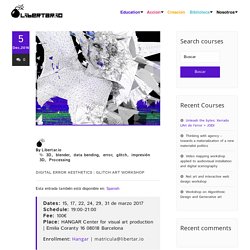
A glitch or computer error is the result of unexpected or intentional variations that occur during the transmission of the information, altering the original data and leaving a new form: the fault. This course combines the theoretical and practical study of glitch art, an all art that incorporates the failure in computer data in the search for new aesthetics, that put in crisis the apparent perfection of machines and computerized systems. We will review examples of machine art from the 19th century in order to understand technological evolution and its influence on aesthetics and philosophy. Personal computer required.
Qu'est-ce que le bélinographe ? Databending using Audacity. Thanks to some help on the Audacity forum I finally know out how to use Audacity to databend.
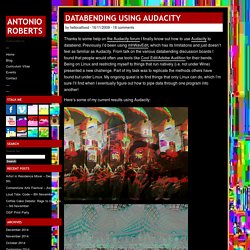
Previously I’d been using mhWavEdit, which has its limitations and just doesn’t feel as familiar as Audacity. Projetsinge: LogforData K7. Projectsinge: LogforData 2. LogforData est une cassette sur laquelle des DATA numériques sont enregistrées sous forme audio.

Ces DATA contiennent le journal d'un personnage imaginaire, celui d'un hacker, qui parcourt une grande partie de l'histoire d'internet, ainsi que des instructions informatiques. Un dispositif analogique-numérique, composé d'un lecteur cassette relié à un ordinateur par son entrée audio, lui-même connecté à la page logfordata.net, permet le décodage et le rendu du contenu de la cassette. 3 moteurs logiciels de rendu (TEXTUEL, SONORE et VISUEL) travaillent en même temps et s'échangent des variables. Le dispositif ainsi mis en place donne à voir et à entendre un univers textuel, sonore et visuel variable à chaque lecture. LogforData K7 / Un projet mené par Jean-François Blanquet. asmir.info/articles/citedelamusique_catalogue2010.pdf. asmir.info/articles/SonZpdt_catalogue2008.pdf. Graphical sound. Daphne Oram : une pionnière anglaise de la musique électronique du bidouillages des bandes sonores et de la musique expérimentale. 22 déc Daphne Oram The Oram Tapes Vol. 1 YOUNG AMERICANS.
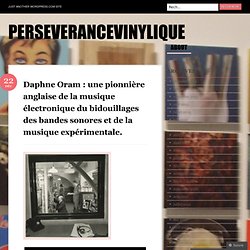
The Oramics Machine (iPhone App) Oramics by DAPHNE ORAM - 2CD. Back in stock!
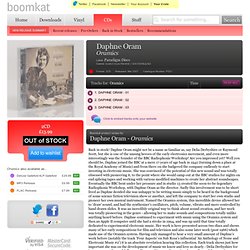
Daphne Oram might not be a name as familiar as, say Delia Derbyshire or Raymond Scott, but she is one of the unsung heroes of the early electronics movement, and even more interestingly was the founder of the BBC Radiophonic Workshop! Are you impressed yet? Well you should be, Daphne joined the BBC at a mere 17 years of age back in 1942 (turning down a place at the Royal Academy of Music) and from there on she badgered the company endlessly to start investing in electronic music. www.centerforvisualmusic.org/LevinPfen.pdf.
Norman McLaren. Un article de Wikipédia, l'encyclopédie libre.

Pour les articles homonymes, voir McLaren. Synchromy. Norman McLaren: Pen Point Percussion. Graphical_sound. Graphical sound or drawn sound techniques are a consequence of the sound-on-film technology and based on the creation of artificial optical polyphonic sound tracks on transparent film.
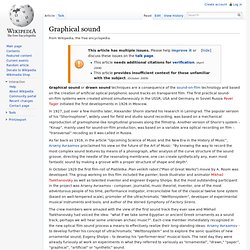
The first practical sound-on-film systems were created almost simultaneously in the USSR, USA and Germany. In Soviet Russia Pavel Tager initiated the first developments in 1926 in Moscow. In 1927, just over a few months later, Alexander Shorin started his research in Leningrad. The popular version of his “Shorinophone”, widely used for field and studio sound recording, was based on a mechanical reproduction of gramophone-like longitudinal grooves along the filmstrip. Dessiner le son : son optique et son graphique. TONEWHEELS. The technology of synthesizing sound from light is a curious combination of research from the realms of mathematics, physics, electronics and communications theory which found realization in the industries of motion picture films, music, surveillance technology and finally digital communications.
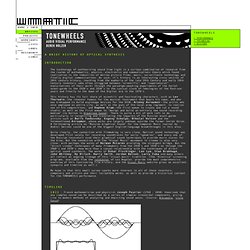
As such, it's history is an interesting cross section of 20th century history, reaching from the euphoria of the late 19th Century and early 20th Century inventors (who often struggled between "scientific" and "supernatural" explainations of their work) through the paradigm-smashing experiments of the Soviet avant-garde in the 1920's and 1930's to the cynical clash of ideologies of the Post-war years and finally to the dawn of the digital era in the 1970's.
Quite clearly, the connection with filmmaking is very close. Fourier Harmonics Helmholtz Resonators. laurent.jullier.free.fr/TEL/LJ2000_AvantGarde.pdf. Imprimer.php3?id_article=79. À la fin des années vingt, est né dans l’univers du cinéma d’animation un procédé sonore unique qui ne trouve pas d’équivalent dans le domaine de la musique pure et que les cinéastes appellent « technique des sons synthétiques » ou « sons synthétiques ».
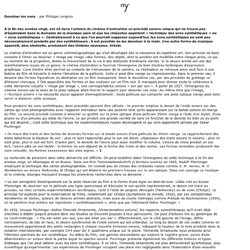
Contrairement à ce que l’on pourrait supposer aujourd’hui, les sons synthétiques ne sont pas nécessairement produits par des synthétiseurs ; il est possible de les dessiner à la main. Une autre forme de musique apparaît, plus abstraite, produisant des timbres nouveaux, irréels. Le cinéma d’animation est un genre cinématographique qui s’est développé dès la naissance du septième art. Son principe de base consiste à filmer ou dessiner « image par image »des formes, des objets, dont la position est modifiée entre chaque prise, ce qui au moment de la projection, donne le mouvement de la vie à des éléments d’ordinaire inertes. Pionniers & Précurseurs - BUCKMINSTER FULLER. OSKAR FISCHINGERGelnhausen, Allemagne, 1900 - Los Angeles Californie, Etats-Unis 1967.
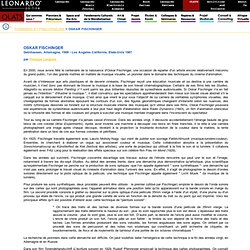
Oskar_fischinger_ornements.pdf. Tönende Ornamente/Ornament Sound. www.multimedialab.be/doc/citations/oskar_fischinger_ornements.pdf.